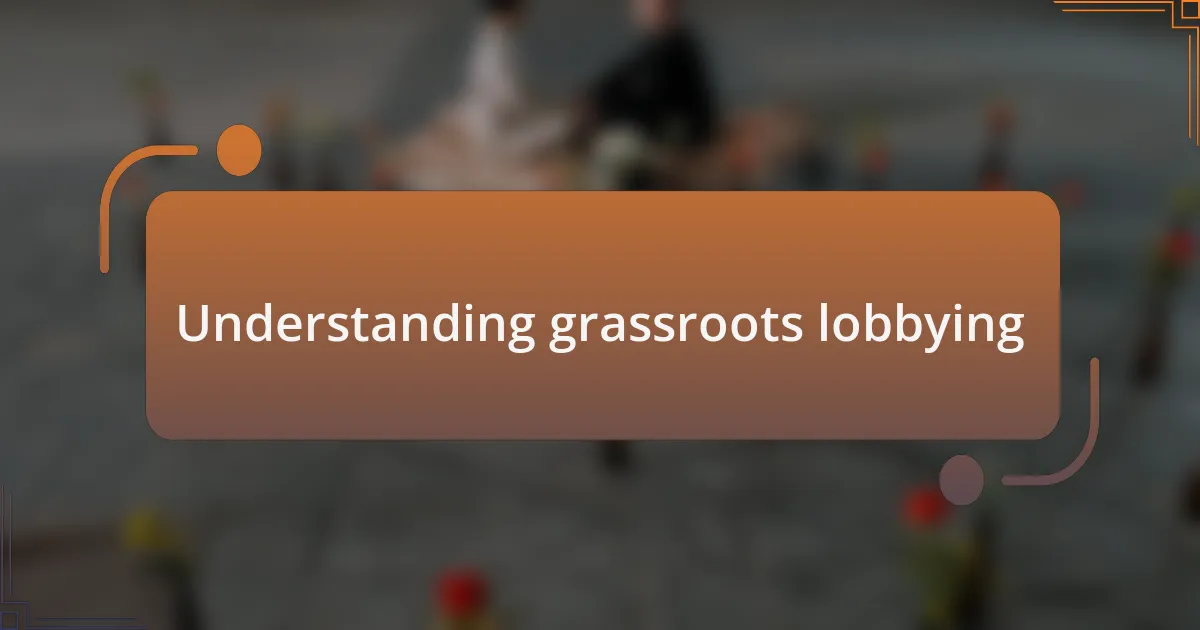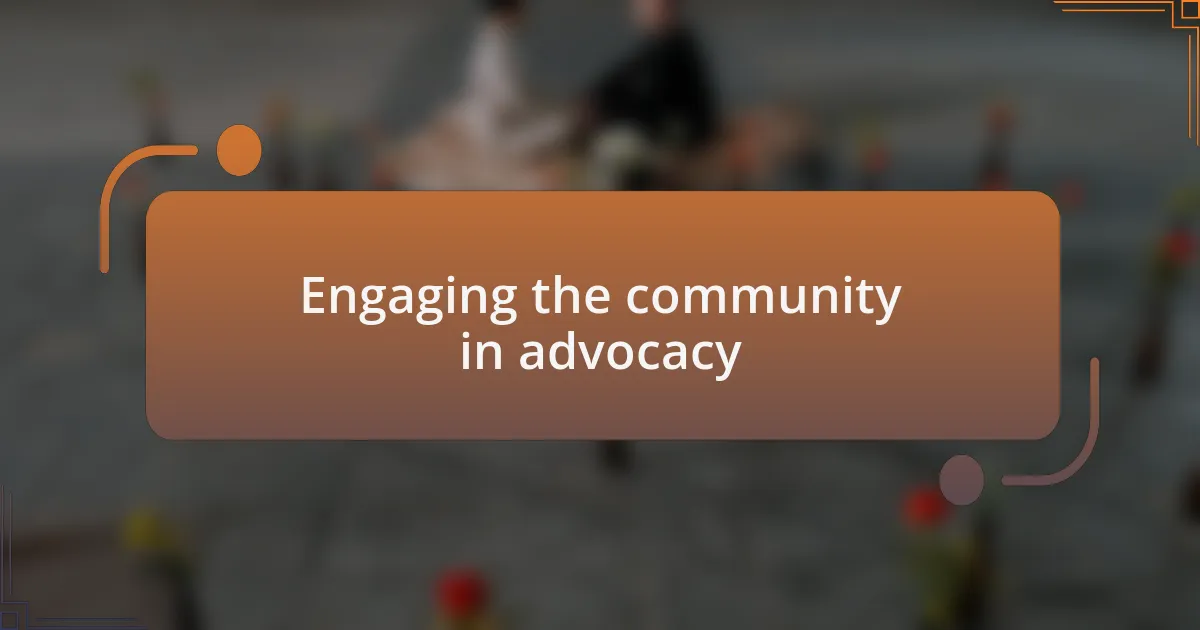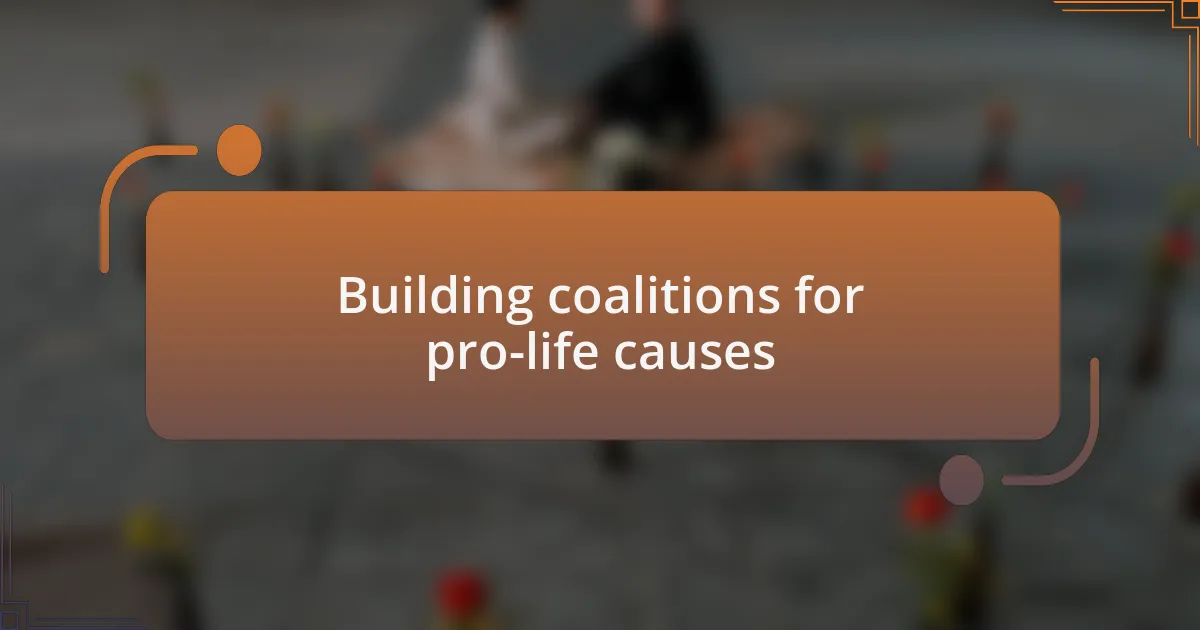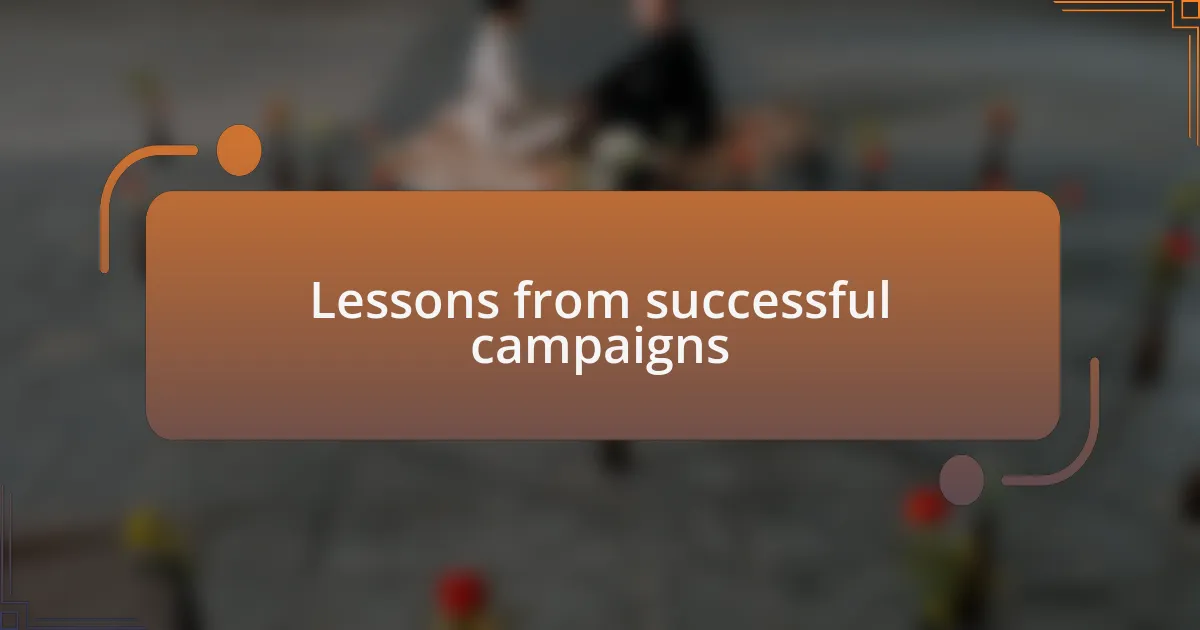Key takeaways:
- Grassroots lobbying empowers citizens to share personal stories, transforming issues into emotional narratives that inspire collective action.
- Pro-life advocacy emphasizes changing hearts and minds through conversation and community engagement, fostering unity and solidarity among supporters.
- Effective strategies for grassroots efforts include organizing local events, utilizing social media, and creating impactful materials that resonate with broader audiences.
- Building coalitions with diverse groups enhances the outreach and credibility of advocacy efforts, demonstrating the strength of collaborative advocacy.

Understanding grassroots lobbying
Grassroots lobbying is fundamentally about the power of everyday citizens coming together to advocate for a cause. I remember my first experience attending a local town hall meeting where community members shared their personal stories. It struck me how deeply personal these narratives were; they made the issues come alive, transforming statistics into real-life concerns that resonate on an emotional level.
At its core, grassroots lobbying encourages individuals to voice their opinions, whether it be through letter-writing campaigns, social media engagement, or direct interaction with lawmakers. I often found myself questioning how effective my own voice could be. But each time I saw someone transformed from a passive observer to an active participant, it reinforced my belief that collective action fosters change.
This type of lobbying relies heavily on local networks, making every person’s contribution vital, regardless of their experience level. I can recall moments when simple conversations sparked a sense of urgency, prompting group actions that felt powerful. It makes me think: What if we all took that first step? How many voices could we amplify together?

The importance of pro-life advocacy
Pro-life advocacy holds immense importance as it defends the sanctity of life from conception to natural death. When I first got involved, I vividly recall standing with fellow advocates at a local rally. The energy was palpable as we shared our hopes, fears, and the drive to protect those who cannot voice their own needs. It made me realize that our presence alone could challenge prevailing narratives about the value of life.
Engaging in pro-life advocacy goes beyond just supporting legislation; it’s about changing hearts and minds. I remember speaking to a friend who was initially indifferent to the issue. As we discussed the impact of abortion on families, I could see her perspective shift. This experience taught me that conversations can break barriers, inspiring more people to join the cause and reaffirming why advocacy is essential.
Moreover, pro-life advocacy fosters a sense of community among those who believe in protecting the vulnerable. I cherish the friendships I’ve developed through shared activism—people whose passion mirrors my own. It begs the question: How many lives could we change if we continue to stand united in our conviction?

Effective strategies for grassroots lobbying
When I think about effective strategies for grassroots lobbying, I often reflect on the power of personal stories. During a community meeting, I shared my own journey related to an unexpected pregnancy and the challenges we faced. Being open and vulnerable not only drew people in but also compelled them to relate on a deeper level, which encouraged them to advocate alongside me for life-affirming policies.
Another strategy that proved beneficial was organizing local events, such as workshops and community forums. I vividly recall hosting a panel discussion that brought together experts and everyday advocates. The engaged audience could ask their questions, fostering a sense of ownership over the conversation about life issues. These events created a ripple effect, motivating participants to share what they learned, broadening awareness outside our immediate circle.
Finally, leveraging social media has transformed grassroots efforts. I started sharing updates and calls to action on my platforms, and the response was overwhelming. People began engaging with our content, sharing their own experiences and inviting others to join the discussion. It left me wondering: how much more could we accomplish if everyone used their unique voice? The collective impact of individual stories can amplify our message in a way that resonates far beyond our local communities.

Engaging the community in advocacy
Engaging the community in advocacy truly flourishes when you create spaces for open dialogue. I remember standing outside a local café, where I set up a booth to discuss pro-life issues. The conversations that unfolded were unexpected; strangers shared their perspectives and personal stories. I saw firsthand how simply inviting people to share led to a deeper understanding of each other’s beliefs. Isn’t it amazing how a casual setting can spark such meaningful exchanges?
In my experience, the influence of partnerships with local organizations cannot be overstated. Collaborating with schools and churches allowed us to reach diverse segments of the community that might otherwise remain untouched. I once worked alongside a local youth group, which helped us gain not only fresh energy but also new ideas; their insights challenged me to think differently about our approach. Don’t you think that involving younger voices can invigorate our advocacy efforts?
Another effective method I found engaging was creating visually impactful materials, such as infographics that present compelling data. I vividly recall the moment we distributed a striking visual at a town event, which simplified complex statistics around abortion rates. The feedback was immediate and enthusiastic; people were eager to discuss the information further. How powerful it is to combine visuals with facts, making daunting topics easier to digest! This experience reinforced my belief in the importance of delivering our advocacy in formats that resonate with our audience, deepening their connection to the cause.

Building coalitions for pro-life causes
Building coalitions for pro-life causes is about tapping into shared values across different groups. During one campaign, I joined forces with a coalition of local non-profits focused on family support. It was eye-opening to see how our diverse backgrounds converged on the common goal of protecting life. Have you ever witnessed such unity in a cause? The strength of our combined resources led to a more robust outreach and greater impact than any of us could have achieved alone.
I often reflect on the relationships formed with people who didn’t initially identify as pro-life. Collaborating with healthcare professionals added an essential layer of credibility to our messaging. One doctor shared her experience with patients facing unexpected pregnancies, which helped shape our narrative in a more compassionate and understanding light. Isn’t it fascinating how personal stories can change perspectives and foster empathy within our community?
Our coalition activities also demonstrated the power of grassroots organizing. I remember hosting a community forum where we invited everyone to voice their concerns. The turnout was extraordinary, and it was rewarding to see individuals from different walks of life engage in thoughtful discussions. Did you know that these forums not only inform but also inspire action? The energy in the room that day reflected a shared commitment to advocacy that I still carry with me.

Personal experiences in lobbying
While volunteering in a local pro-life campaign, I recall standing outside a clinic holding signs and engaging passersby in conversation. One moment that sticks with me is when a woman stopped, visibly upset after a difficult personal experience. We spoke for nearly an hour, and it was humbling to witness how sharing my own story about choosing life for my child helped her feel less alone. How can a simple conversation change someone’s perspective?
During another lobbying effort, I attended a meeting with local legislators. Initially, I felt a wave of nervousness as I prepared to present our case. However, when I started to share my reasons for supporting pro-life initiatives, I noticed nods of agreement among the audience. Connecting my experiences to the broader implications of our cause was invigorating. Have you ever felt that rush of empowerment when your voice contributes to a larger narrative?
One memorable experience involved organizing a letter-writing campaign that encouraged community members to reach out to their representatives. The response was phenomenal, and many participants expressed feeling a newfound sense of purpose. Witnessing individuals transform from passive supporters into active advocates was incredibly inspiring. How impactful do you think it is when people realize their voice matters in the political arena? It’s moments like these that reaffirm the vital role grassroots lobbying plays in shaping policy and opinion.

Lessons from successful campaigns
Successful grassroots campaigns often hinge on the power of genuine connection. I remember a time when we gathered people from diverse backgrounds to share their stories at a community forum. The atmosphere was electric, and it struck me how those raw, heartfelt testimonies forged an emotional bond among attendees. Isn’t it fascinating how vulnerability can unite us in a common cause?
Another critical lesson I learned from these campaigns is the importance of persistence. In one instance, we faced significant pushback during a town hall meeting. Instead of feeling discouraged, our team rallied together, prepared more fact-based arguments, and returned with more determination. This experience taught me that every setback can be a setup for a more compelling comeback. Have you ever felt that renewed sense of purpose after overcoming an obstacle?
Engaging with our local representatives is another key aspect of successful lobbying. I recall attending a legislative breakfast where constituents could meet their elected officials. I was struck by how many representatives genuinely wanted to hear from their constituents. The experience reaffirmed my belief that personal stories can be more persuasive than statistics. How often do we overlook the power of direct communication in driving change?